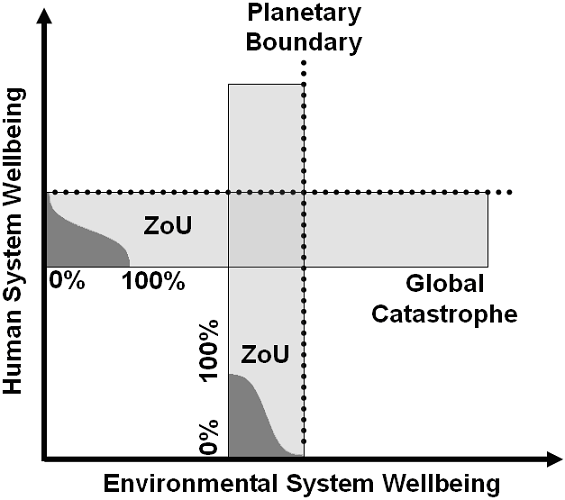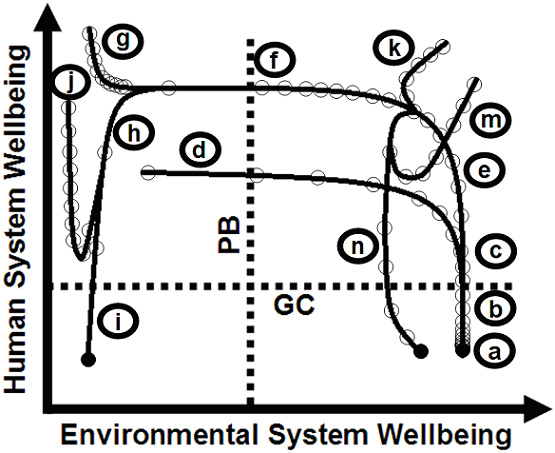Integrating the planetary boundaries and global catastrophic risk paradigms
A framework for analyzing global threats to humanity and nature, illustrated with the case of the phosphorus biogeochemical cycle.
Seth D. Baum and Itsuki C. Handoh, 2014. Integrating the planetary boundaries and global catastrophic risk paradigms. Ecological Economics, vol. 107 (November), pages 13-21.
Pre-print: Click here to view a full pre-print of the article (pdf).
Abstract:
Planetary boundaries (PBs) and global catastrophic risk (GCR) have emerged in recent years as important paradigms for understanding and addressing global threats to humanity and the environment. This article compares the PBs and GCR paradigms and integrates them into a unified PBs-GCR conceptual framework, which we call Boundary Risk for Humanity and Nature (BRIHN). PBs emphasizes global environmental threats, whereas GCR emphasizes threats to human civilization. Both paradigms rate their global threats as top priorities for humanity but lack precision on key aspects of the impacts of the threats. Our integrated BRIHN framework combines elements from both paradigms' treatments of uncertainty and impacts. The BRIHN framework offers PBs a means of handling human impacts and offers GCR a theoretically precise definition of global catastrophe. The BRIHN framework also offers a concise stage for telling a stylized version of the story of humanity and nature co-evolving from the distant past to the present to multiple possible futures. The BRIHN framework is illustrated using the case of disruptions to the global phosphorus biogeochemical cycle.
Non-Technical Summary: pdf version
Background: Planetary Boundaries and Global Catastrophic Risk
Planetary boundaries (PBs) and global catastrophic risk (GCR) are two paradigms that have emerged in recent years to study major global threats to humanity and nature. PBs focuses on threats that can push the global Earth system into fundamentally different states, with unacceptable consequences for humanity. GCR focuses on threats that can cause the permanent collapse of global human civilization or even human extinction, including environmental threats and other threats. PBs and GCR come from different intellectual traditions and have different conceptual bases. This paper integrates PBs and GCR into a new framework, which we call Boundary Risk for Humanity and Nature (BRIHN). The paper illustrates BRIHN using the example of the phosphorus biogeochemical cycle, which can cause great harm to nature but might not be a catastrophe for humanity, illustrating the importance of looking at both.
Treatment of Uncertainty: Probabilistic Thresholds
Global-scale human-environmental systems are highly complex, and thus cannot be understood in full detail. Because of this, both PBs and GCR make great effort to handle the uncertainty in the threats they study. PBs focuses on Earth system thresholds that would be dangerous if crossed. Given uncertainty about where the thresholds are, PBs sets boundaries at a safe distance from the thresholds. As long as the boundaries are not crossed, the threshold probably will not be crossed either. GCR focuses on events that would be catastrophic if they occurred. Given uncertainty about which catastrophes might occur, GCR proposes to reduce the overall probability of catastrophe. BRIHN integrates these two treatments of uncertainty with probabilistic thresholds, which proposes to reduce the probability of crossing thresholds.
Treatment of Impacts: Human and Environmental System Boundaries
PBs and GCR are both vague about the impacts of the threats they study. PBs holds that crossing thresholds would be unacceptable to humanity, but the thresholds themselves are about nature, not about humanity. GCR focuses on catastrophes causing large declines in total human wellbeing, but is vague about how large the declines would be. BRIHN integrates these two treatments of impacts by setting boundaries for both human and environmental systems. The environmental system boundary is the same as a PB; crossing it risks a catastrophe for nature. The human system boundary is a new concept; crossing it risks a catastrophe for humanity. This catastrophe for humanity offers a new, more precise definition of global catastrophe.
Storytelling with BRIHN
BRIHN can further be used to tell a simplified version of the story of humanity and nature co-evolving from the distant past into the future, for phosphorus and for other threats. The story shows human wellbeing and environmental wellbeing changing over time, going above and below their respective boundaries. As boundaries are crossed, conditions can change dramatically. An important research question is whether crossing the environmental system boundary (resulting in a catastrophe to nature) will lead to the human system boundary also being crossed (resulting in a catastrophe to humanity). How this question is answered could determine how important it is for humanity to protect the environment from crossing planetary boundaries.

The BRIHN framework. Treatment of uncertainty includes the use of boundaries (dotted lines) and zones of uncertainty (light grey shading) from PBs research, plus the use of probability distributions (dark grey shading) and probabilities (0% to 100%) from GCR research. Treatment of impacts includes the use of thresholds (located somewhere in the zone of uncertainty) from PBs research, plus the use of total system wellbeing (X and Y axes) from GCR research. The human system boundary is a new concept.

Storytelling with BRIHN. Shown here is the story of humanity and nature co-evolving for phosphorus. Points a through c show past through present. Points d through n show possible future stories. Circles represent time passing and are closer together when time passes more slowly. Conditions changed slowly during early history (a-b) and change especially rapidly during certain catastrophe scenarios (d, f, h, i).
Created 2 Aug 2014 * Updated 24 Aug 2014

